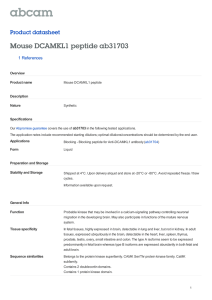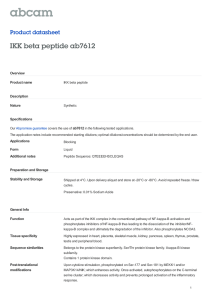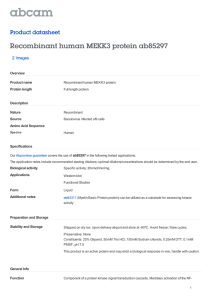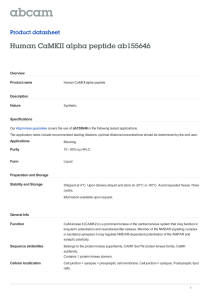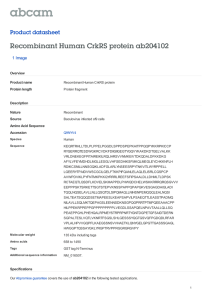Mon, Apr 2, 8:00 AM - 12:00 PM 1683/2
advertisement
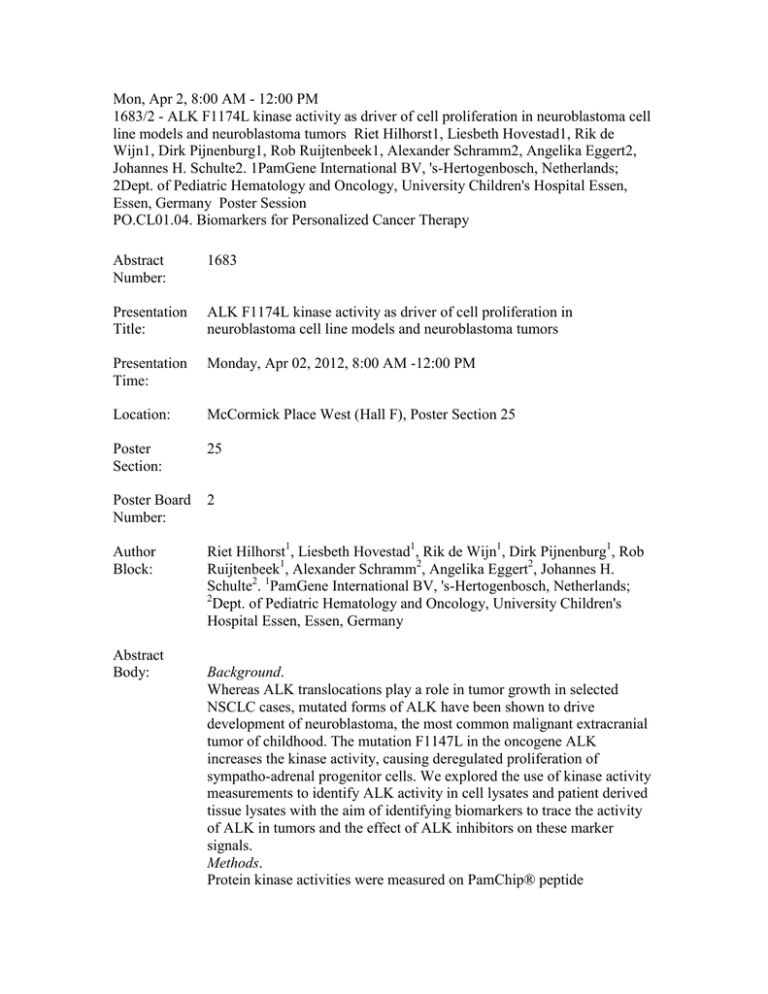
Mon, Apr 2, 8:00 AM - 12:00 PM 1683/2 - ALK F1174L kinase activity as driver of cell proliferation in neuroblastoma cell line models and neuroblastoma tumors Riet Hilhorst1, Liesbeth Hovestad1, Rik de Wijn1, Dirk Pijnenburg1, Rob Ruijtenbeek1, Alexander Schramm2, Angelika Eggert2, Johannes H. Schulte2. 1PamGene International BV, 's-Hertogenbosch, Netherlands; 2Dept. of Pediatric Hematology and Oncology, University Children's Hospital Essen, Essen, Germany Poster Session PO.CL01.04. Biomarkers for Personalized Cancer Therapy Abstract Number: 1683 Presentation Title: ALK F1174L kinase activity as driver of cell proliferation in neuroblastoma cell line models and neuroblastoma tumors Presentation Time: Monday, Apr 02, 2012, 8:00 AM -12:00 PM Location: McCormick Place West (Hall F), Poster Section 25 Poster Section: 25 Poster Board Number: 2 Author Block: Riet Hilhorst1, Liesbeth Hovestad1, Rik de Wijn1, Dirk Pijnenburg1, Rob Ruijtenbeek1, Alexander Schramm2, Angelika Eggert2, Johannes H. Schulte2. 1PamGene International BV, 's-Hertogenbosch, Netherlands; 2 Dept. of Pediatric Hematology and Oncology, University Children's Hospital Essen, Essen, Germany Abstract Body: Background. Whereas ALK translocations play a role in tumor growth in selected NSCLC cases, mutated forms of ALK have been shown to drive development of neuroblastoma, the most common malignant extracranial tumor of childhood. The mutation F1147L in the oncogene ALK increases the kinase activity, causing deregulated proliferation of sympatho-adrenal progenitor cells. We explored the use of kinase activity measurements to identify ALK activity in cell lysates and patient derived tissue lysates with the aim of identifying biomarkers to trace the activity of ALK in tumors and the effect of ALK inhibitors on these marker signals. Methods. Protein kinase activities were measured on PamChip® peptide microarrays comprising 144 Tyr containing peptide sequences from known human phosphorylation sites. The activity profiling experiments involved recombinant ALK kinase, lysates of cell lines overexpressing ALK and neuroblastoma tumors with elevated ALK F1174L presence. Per microarray analysis 5 ug of total protein was used in the presence of 100 uM ATP. Experiments were performed in the presence and absence of ALK kinase inhibitors crizotinib and NVP-TAE684. Real time kinetics of 144 peptide phosphorylations were measured with a fluorescently labeled antibody. Results. Phosphorylation profiles for neuroblastoma tumors, ALK overexpressing cell lines and recALK were generated. For recALK 48 novel peptide substrates were identified that showed signals depending on both ATP and kinase concentration and inhibition by the ALK inhibitors. In ALK overexpressing cell lines, but not in control cell lysates, signals on many ALK substrate peptides were significantly elevated, and returned to baseline level in the presence of ALK inhibitors. Whereas neuroblastomas with low ALK expression gave similar kinase activity profiles, the tumors harboring the ALK F1174L mutation were different, suggesting a more complex regulation of phosphorylation activity in these tumors. All tumors showed on-chip responses with ALK inhibitor drugs, but to different extent, which could be a basis for response prediction biomarker discovery. Conclusion. ALK activity of recombinant kinases, cell lysates and tumor lysates can be detected on PamChip® peptide microarrays. Based on results with model systems, this method shows promise to identify tumors that express elevated ALK activity and to study response of this class to ALK inhibitors. Tue, Apr 3, 8:00 AM - 12:00 PM 3608/10 - Measurement of kinase activity in cancer cell lines and tumor tissue using a tyrosine kinase peptide substrate array Mariette Labots, Kristy J. Gotink, Henk Dekker, Johannes C. van der Mijn, Henk J. Broxterman, Maria N. Rovithi, Connie R. Jiménez, Henk M.W. Verheul. VU University Medical Center, Amsterdam, Netherlands Poster Session PO.CL13.07. Biomarker Targets, Assays, and Models Abstract Number: 3608 Presentation Title: Measurement of kinase activity in cancer cell lines and tumor tissue using a tyrosine kinase peptide substrate array Presentation Time: Tuesday, Apr 03, 2012, 8:00 AM -12:00 PM Location: McCormick Place West (Hall F), Poster Section 23 Poster Section: 23 Poster Board Number: 10 Author Block: Mariette Labots, Kristy J. Gotink, Henk Dekker, Johannes C. van der Mijn, Henk J. Broxterman, Maria N. Rovithi, Connie R. Jiménez, Henk M.W. Verheul. VU University Medical Center, Amsterdam, Netherlands Abstract Body: Introduction Tyrosine kinases play an important role in tumor biology. Their activity can be measured using a kinase peptide substrate array consisting of 144 Tyr residue-containing peptides (PamChip®, PamGene, Den Bosch, The Netherlands). We evaluated this platform for the measurement of kinase activity in tumor tissue and cancer cell lines under various experimental conditions. Methods Lysates of colorectal and renal cancer cell lines, HCT116 and 786-0 respectively, were made using both Mammalian and Tissue Protein Extraction Reagent (M-PER and T-PER, Thermo Scientific) and RadioImmunoprecipitation Assay (RIPA, home made) buffer. Lysates from patient-derived tumor tissues were prepared by adding T-PER to several 10 μm cryoslides containing >50% tumor. After lysate incubation with reaction buffer containing a fluorescent labeled antibody against phospotyrosine and ATP, kinase activity profiles were determined on kinetics of recorded peptide substrate phosphorylation intensities. The effect of protein and ATP concentration, different lysis buffers and number of freeze-thaw cycles on basal kinase activity was studied. Sunitinib, sorafenib and dasatinib, clinically available tyrosine kinase inhibitors (TKIs), were used to differentially inhibit kinase activity in the lysates. Results Application of 2.5-15 µg protein in 40 µl sample mix per array revealed linearly increasing phosphorylation signal intensities and initial velocities (Vini) of the kinetic curve (R2 = 0.98). Increasing ATP concentrations induced phosphorylation signal intensities, but above 400 µM the curve deviated from linearity. Basal kinase activity profiles of cell lines and tumor tissues were reproducible with CV’s below 15%, with good signalto-background ratios and low aspecific binding. Different lysis buffers resulted in a maximum variation of phosphorylation signal intensity of 47±5.7% in both cell lines without affecting the actual profile. Quadruple freeze-thawing of lysates did not affect signal intensities by more than 10%. Inhibition profiles of treated vs. control lysates were reproducible within and between experiments, showing a higher and differential number of inhibited peptides at increasing TKI concentrations. In contrast to the ATP-independent inhibition of dasatinib, ATP-dependent inhibition for sunitinib and sorafenib was demonstrated by combining a fixed drug concentration with increasing concentrations of ATP up to 800 µM. Conclusion Kinase activity in lysates from cancer cell lines and patient-derived tumor tissue can be reproducibly profiled with a tyrosine kinase peptide substrate array. In addition, TKIs show differential ATP-dependent inhibition profiles on this array. Taken together, we expect that arraybased tumor kinase activity profiling may lead to specific TKIphosphorylation fingerprints for personalized treatment. Sun, Apr 1, 1:00 - 5:00 PM 863/20 - Tyrosine kinase activity profiling of metastatic malignant melanoma: Identification of possible therapeutic targets and markers predicting response to therapy Andliena Tahiri1, Kathrine Roe2, Christian Busch3, Per Eystein Lonning3, Anne H. Ree1, Vessela N. Kristensen1, Juergen Geisler1. 1Institute of Clinical Medicine, Division of Clinical Medicine and Laboratory Sciences, University of Oslo, and Akershus University Hospital, Lørenskog, Norway; 2Oslo University Hospital Radiumshospitalet, Oslo, Norway; 3Haukeland University Hospital and University of Bergen, Bergen, Norway Poster Session PO.ET06.01. Kinase and Phosphatase Inhibitors 1 Abstract Number: 863 Presentation Title: Tyrosine kinase activity profiling of metastatic malignant melanoma: Identification of possible therapeutic targets and markers predicting response to therapy Presentation Time: Sunday, Apr 01, 2012, 1:00 PM - 5:00 PM Location: McCormick Place West (Hall F), Poster Section 32 Poster Section: 32 Poster Board Number: 20 Author Block: Andliena Tahiri1, Kathrine Roe2, Christian Busch3, Per Eystein Lonning3, Anne H. Ree1, Vessela N. Kristensen1, Juergen Geisler1. 1Institute of Clinical Medicine, Division of Clinical Medicine and Laboratory Sciences, University of Oslo, and Akershus University Hospital, Lørenskog, Norway; 2Oslo University Hospital Radiumshospitalet, Oslo, Norway; 3Haukeland University Hospital and University of Bergen, Bergen, Norway Abstract Body: Metastatic melanoma is an aggressive form of skin cancer that is highly resistant to conventional chemotherapy. Thus, novel approaches to improve the current treatment of advanced melanoma are urgently needed. Kinases are key regulators of cellular processes, and since nearly half of the tyrosine kinase complement is implicated in cancer, the information of kinase activity in tumors give important tumor-specific information on affected pathways and potential targets for treatment. With this in mind, we performed tyrosine kinase activity profiling of 26 tissue samples obtained from patients suffering from metastatic stage IV melanoma, prior to dacarbazine (DTIC) treatment, using Tyrosine Kinase PamChip® microarrays. Each sample lysate generated an individual phospho-substrate signature, representing the state of the kinase signalling cascades, which allowed us to compare affected targets in responders and non-responders to DTIC treatment. Further, we attempted to evaluate the kinase activity in response to BRAF inhibitor, PLX4032 (Vemurafenib), which has shown dramatic and positive effects in advanced melanoma tumors, and has recently been approved for the treatment of late stage melanoma. In this case, incubation was carried out on all samples with and without PLX4032. Our preliminary results showed that although the compound is mainly directed against a serine/threonine kinase, BRAF, PLX4032 also showed inhibitory effects on the activity of multiple tyrosine kinases. Since the drug is only beneficial for melanoma patients with BRAF V600E mutations, we compared the activated kinase pathways in patients with and without this mutation in order to identify alternative survival pathways in patients with wild type BRAF. The technology used in this study is based on a unique 3D flow-through microarray format that allows monitoring of the reaction in real time, ideal for the characterization of pathways. Each array contained 144 peptide substrates with sites for phosphorylation, representing about 100 different proteins. The use of kinase inhibitors will cause inhibition of corresponding kinases of activated signalling pathways; hence, providing us leads to therapeutic targets and possible prediction markers for response to therapy. The detailed effects of both PLX4032 and sunitinib in the chosen test system are currently prepared for presentation. Sun, Apr 1, 1:00 - 5:00 PM 862/19 - Pre-clinical and molecular analysis of Crizotinib in c-Met positive uveal melanoma Mark J. de Lange, Mieke Versluis, Gre P.M. Luyten, Martine J. Jager, Pieter A. van der Velden. LUMC, Leiden, Netherlands Poster Session PO.ET06.01. Kinase and Phosphatase Inhibitors 1 Abstract Number: 862 Presentation Title: Pre-clinical and molecular analysis of Crizotinib in c-Met positive uveal melanoma Presentation Time: Sunday, Apr 01, 2012, 1:00 PM - 5:00 PM Location: McCormick Place West (Hall F), Poster Section 32 Poster Section: 32 Poster Board Number: 19 Author Block: Mark J. de Lange, Mieke Versluis, Gre P.M. Luyten, Martine J. Jager, Pieter A. van der Velden. LUMC, Leiden, Netherlands Abstract Body: Uveal melanoma (UM) is an intraocular neoplasm with an annual incidence of 7 per million. UM originates from melanocytes just like cutaneous melanoma (CM) and similar to CM, the RAS/RAF/MEK/ERK pathway is involved in the development of UM. However, not all UM seem to depend on the activation of this pathway. Loss of ERK signalling may be correlated with progression as the ERK negative cells are derived from UM metastasis. In these tumours, cells apparently use a different pathway to proliferate and survive. In order to identify treatment targets for metastasis patients we set out to identify the pathway which stimulates proliferation in the ERK negative UM cells. Growth factor receptor screening revealed that activation of c-Met or HGF receptor, is inversely correlated with ERK activation leaving the metastatic UM, halfway progression to metastasis, with both c-Met and ERK activated. In this study, we tested the efficacy of c-Met inhibitor Crizotinib and investigated primary and downstream targets to delineate the role of cMet signalling in UM progression. Crizotinib was shown to specifically inhibit c-Met positive UM and this was most clear when cells were grown anchorage independent, in line with a role in dissemination for c-Met. With phospho-proteomics we showed that c-Met is the primary target of Crizotinib in UM while FAK emerges as the prime downstream target. Moreover, Src was shown to be the downstream kinase that transmits the c-Met signal to both FAK and ERK in metastatic UM. In UM metastasis, lacking active ERK, Src is absent and FAK is directly activated by c-Met. Combined, our data support the use of Crizotinib in late stage UM and reveals altered c-Met signalling in uveal melanoma progression.

